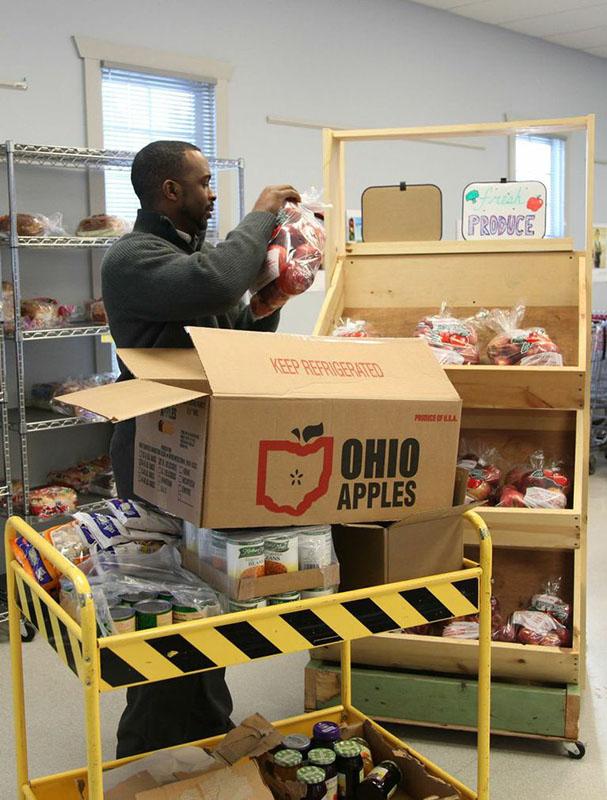SNAP Cuts Increase Demand on Local Pantries
Food Distribution Coordinator Alan Mitchell at Oberlin Community Services stocks produce and nonperishable items as he prepares to serve food-insecure Ohioans.
February 14, 2014
Recent financial cuts to the Supplemental Nutrition Assistance Program are causing an exponential increase in the number of citizens forced to frequent food pantries across the nation. In Lorain County, where 14.2 percent of the population is food insecure, only 6.8 percent of the population is eligible for the financial benefits provided by the remaining SNAP programs.
On Nov. 1, the expiration of the 2009 American Recovery and Reinvestment Act resulted in a 5.5 percent drop in maximum food stamp benefits. Ohio saw $193 million in SNAP cuts, which affected almost 1.85 million people or 16 percent of Ohio’s population. As of 2011, the average cost of a meal in Ohio was $2.41, while the eradication of the American Recovery and Reinvestment Act, has resulted in reducing the average nationwide SNAP benefits to less than $1.40 per meal.
Kris Hebble, a member of the vestry at St. Andrew’s Episcopal Church Food Pantry in downtown Elyria, described some of the issues with the cuts.
“Because of the cuts, they’re not sure how they’re going to pay for food and gas. So they’re finding it difficult to choose between the two and the way the pantry’s set up [is that] it’s emergency use so we’re happy to give as much as we can but unfortunately it’s just not enough sometimes,” said Hebble.
The SNAP cuts are a result of the newly reformed Farm Bill, a piece of legislation that will reduce federal spending by $23 billion over the next 10 years. In redrafting the bill, legislators removed several regulations and additives, including a ruling known as the “heat and eat” loophole.
SNAP recipients’ income and other expenses, including utilities, are taken into consideration when awarding SNAP benefits. These increase if the recipient also receives utility assistance from the Low-Income Home Energy Assistance Program. In states such as Massachusetts, as little as $1 in fuel assistance benefits per year will allow recipients to apply for an increase in their SNAP benefits. The removal of the “heat and eat” loophole — the practice of awarding token LIHEAP assistance to increase SNAP benefits — has been scrutinized as an unfair ruling in light of the underfunding of the Food Stamp Program by critics of the Farm Bill.
Since 2009, the average number of people served in food pantries across Lorain County has been steadily increasing.
“We’ve had an increase as well in the number of what I would say are predominately middle class client, and most of them are rather shy to talk,” said Hebble, “but they’ve said they can’t understand what’s going on because they’ve worked all their lives, they have decent jobs, it’s just at this point they’re finding it so difficult to put food on the table and get everything else that’s required out of life.”
Juliana Chase-Morefield, the executive director of Second Harvest Food Bank, an organization that provides food to over 50,000 people across four counties in northern Ohio, commented on the impact of the increase.
“What we saw from November and December of 2012 to November and December of 2013 was about a 10 percent increase in the number of people who need help at food pantries. That’s a pretty significant increase from one holiday season to another,” said Chase-Morefield.
St. Andrew’s Episcopal Church Food Pantry is one of the many kitchens in the area that receive a large portion of their food from Second Harvest Food Bank. According to Hebble, St. Andrew’s served 716 people in December of 2013, a figure that is up almost 33 percent from 481 people in December of 2012. This past January they served 924 people, a 15 percent increase over 2013.
“All food pantries have really seen a significant increase in the demand for food pantry services as a result of the food stamp cuts,” said Anne Spelic, the executive director at Lorain County Office on Aging.
Some Ohio residents have had additional SNAP benefits cut as a result of Governor John Kasich’s directive, which requires able-bodied adults without dependents to work at least 20 hours a week in order to qualify for assistance. The directive, which took effect this January, pertains to 77 of Ohio’s 88 counties and is projected to apply to approximately 3,600 of Lorain County’s residents. Chase-Morefield estimates that about one third of those residents were unable to find jobs before the directive took effect.
“We’ve done the best we can to increase the amount of food we have available,” said Spelic. “We’ve had to do some additional food drives to try to increase the capacity of our pantry to try to serve those in need.”
Other states currently experiencing similar SNAP-related food insecurities are California, Connecticut, Delaware, Maine, Massachusetts, Michigan, Montana, New Jersey, New York, Oregon, Pennsylvania, Rhode Island, Vermont, Washington and Wisconsin and Washington D.C.


























